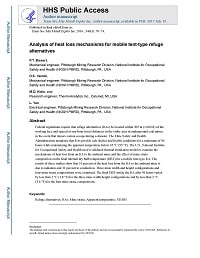Mining Publication: Analysis of Heat Loss Mechanisms for Mobile Tent-Type Refuge Alternatives
Original creation date: July 2017
Authors: PT Bissert, DS Yantek, MD Klein, L Yan
NIOSHTIC2 Number: 20049268
2016 SME Annual Conference and Expo: The Future for Mining in a Data-Driven World, February 21-24, 2016, Phoenix, Arizona. Englewood, CO: Society for Mining, Metallurgy, and Exploration, Inc., 2016 Jul; :119-122
Federal regulations require that refuge alternatives (RAs) be located within 305 m (1,000 ft) of the working face and spaced at one-hour travel distances in the outby area in underground coal mines, in the event that miners cannot escape during a disaster. The Mine Safety and Health Administration mandates that RAs provide safe shelter and livable conditions for a minimum of 96 hours while maintaining the apparent temperature below 35 °C (95 °F). The U.S. National Institute for Occupational Safety and Health used a validated thermal simulation model to examine the mechanisms of heat loss from an RA to the ambient mine and the effect of mine strata composition on the final internal dry bulb temperature (DBT) for a mobile tent-type RA. The results of these studies show that 51 percent of the heat loss from the RA to the ambient mine is due to radiation and 31 percent to conduction. Three mine width and height configurations and four mine strata compositions were examined. The final DBT inside the RA after 96 hours varied by less than 1 °C (1.8 °F) for the three mine width/height configurations and by less than 2 °C (3.6 °F) for the four mine strata compositions.

NIOSHTIC2 Number: 20049268
2016 SME Annual Conference and Expo: The Future for Mining in a Data-Driven World, February 21-24, 2016, Phoenix, Arizona. Englewood, CO: Society for Mining, Metallurgy, and Exploration, Inc., 2016 Jul; :119-122
- Announcing Two New Sister Publications on Refuge Alternatives
- Effects of Mine Strata Thermal Behavior and Mine Initial Temperatures on Mobile Refuge Alternative Temperature
- Emergency Escape and Refuge Alternatives
- Estimation of Metabolic Heat Input for Refuge Alternative Thermal Testing and Simulation
- Investigation of Temperature Rise in Mobile Refuge Alternatives
- Portable Refuge Alternatives Temperature and Humidity Tests
- Prediction of Human Core Temperature Rise and Moisture Loss in Refuge Alternatives for Underground Coal Mines
- Refuge Alternatives in Underground Coal Mines
- Technology News 537 - NIOSH Develops New Mine Refuge Chamber Training
- Temperature Rise Within a Mobile Refuge Alternative (RA) - Experimental Investigation and Model Validation